Lea Wait's Blog, page 3
November 7, 2025
Democracy…Some Assembly Still Required

John Clark taking you inside an election. On Tuesday, I served as a ballot clerk for the fifth time. While it was an off-year election, voting was steady and the numbers higher than usual, something I believe was true all across the country.
Here in Waterville, as I expect it is in most places of any size, the process of holding an election starts well before the election. Poll workers need to be recruited in sufficient numbers so things go smoothly, a suitable polling place must be secured, workers need to attend a training session, even if they have worked prior elections. Patti Dubois, our city clerk, does a stellar job of preparing for an election. Her slide presentation during training, is easy to follow, covers everything, and is enhanced by her enthusiasm and sense of humor. We are reminded numerous times that in terms of the election, we’re Switzerland, no matter how we might feel about the issues or candidates.
Our municipal elections are held in the gym at Thomas College. Setup happens the night before and involves tables, polling booths, stanchions with plastic chains to guide voters, as well as revising the assignment list to address changes if people can’t cover their shift. Assignments include the following: traffic control (both in the parking lot and foot traffic inside) booth management, overseeing the ballot machines, check-in of voters, ballot distribution, voter registration, absentee ballot counting on the Friday preceding the election, and specialization tasks (answering unanticipated questions, handling changes of address, and name changes). One young voter who came to our table with a COR (change of registration) card changed their name from one that was female to male.
Every election is a learning experience for me. This time my biggest new bit of knowledge was that write-in candidates must announce their candidacy sixty days before the election in order to have their votes counted. This election had few overtly political comments by voters, but I had to keep a neutral face twice when people getting ballots made reference to how next year we’d be asking them for an ID. Voting results when I got up the next morning validated my faith in Mainers when I saw that The voter ID referendum was soundly defeated and the Red Flag one was soundly passed.
Poll workers can work a full shift-twelve hours, or a half shift. I usually do a full one, but was assigned a six hour shift this time. I welcomed voters whose last name began with letters f through j. Each town prints out an updated list provided by the Secretary of State’s office just before the election to ensure it being as accurate as possible. Once the election is over, name and address changes, as well as new voter registrations are sent to the same office so rolls can be updated.
Several times during my shift, one of the workers came around with a new list of absentee voters and we entered AV(already voted) beside their names to ensure accuracy and integrity of the voting process. When voters come through the line, we ask for their name, find it in the list and verify the address. If there are any changes that need to be made, they’re sent to the person designated to fill out a Change of Registration card. Once that is done, they return to us and we make the necessary changes on the master list. Since we had some municipal races and a city referendum, voters were given two ballots. We had three different local ballots to reflect the races, or lack thereof. Ward three and five got different ballots to reflect races for school board and city council. Everyone else got one that had water district trustees and a charter amendment on it.
The charter amendment reflects a reality that more and more small cities in Maine are facing. It asked voters to approve removing the requirement that a city manager reside in Waterville. We’ve been trying to hire a new one for months without success because the kind of candidate we want usually has a home somewhere else and is reluctant to move.
Secretary of State Shenna Bellows and several members of her staff stopped by around closing time to check on how things were going. They thanked us for helping make the election run smoothly.
Greeting voters is something I really enjoy, especially ones who bring their children. I thank each youngster for coming and watching democracy in action. That action was reinforced by a photo my daughter put on Facebook the day after of the election. It was of five year old Gemma, who was adamant she wanted to go to the polls in Poland and ‘vote’ before going to kindergarten.
Once the polls close, we make a big red X on all remaining ballots to ensure integrity, pack everything up, and issue a big sigh of relief at another job well done. In 2026, we’ll have two extremely important elections, the June primary and the general election in November. I can guarantee your town or city will need more poll workers to handle the number of voters we’ll see. If you’re willing, please volunteer to help keep democracy going.

This little lady threw a fit when she heard we were going to vote after dropping her off at school bc she wanted to go vote too. So we went early and voted before school (she has dance until late so we couldn’t do it after school). She didn’t want to wait until next year to vote!
November 5, 2025
Crime Bake Preview: Honoring Barb Ross and Launching Snakeberry
The New England Crime Bake will take place this weekend, and I can’t wait.
The ‘Bake is the annual gathering of crime writers and readers from across the region held each November outside of Boston. This year’s Guest of Honor is Lori Rader-Day, whose newest crime novel, Wreck Your Heart, will be out in January. Lori’s protagonist is an up-and-coming country western singer named Doll Devine who has provided plenty of inspiration to conference planners. In addition to a full weekend of classes, panels, roundtables and interviews, Crime Bake 2025 will feature some down home socializing that—rumor has it— may involve line dancing at the Saturday night banquet.

Our own Barbara Ross, author of the wonderful Maine Clambake Mystery Series, will honored this year with the Lifetime Achievement Award.
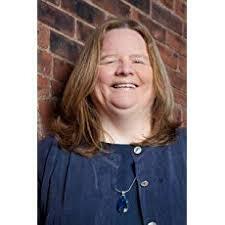
Barbara Ross
Barb has long been a leading light in the New England crime writing community. In addition to writing wonderful novels and novellas, she’s sat on many a board and organizing committee, and is always the first to volunteer to help organize a conference, critique other writers’ manuscripts and participate in group readings.
It will be a joy to celebrate Barb this weekend.
Another highlight will be the launch of SNAKEBERRY: Best New England Crime Stories 2025, the latest edition of the anthology edited by the terrific team of Leslie Wheeler, Susan Oleksiw, Ang Pompano and Christine Bagley. They are gifted and thoughtful editors, and I look forward to the release of their curated collection of short stories every year. The work of five Maine residents included in SNAKEBERRY — Bruce Coffin, Laurel Hanson, Moe Moeller, Gabi Stiteler and me.
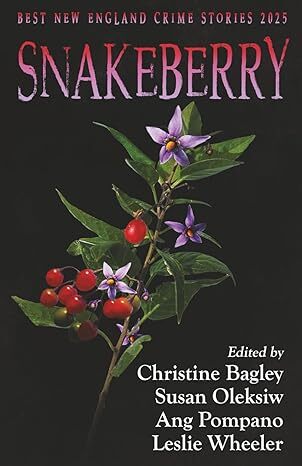
Bruce’s story, called WRITER’S BLOCK, is about an eccentric writer nursing old resentments.
Laurel’s OUT OF THE REACH is about a man who believes himself to be clever being outwitted by people he’d long underestimated.
Moe’s story, THE LAST STONE FROM THE HOUSE OF USHER, re-imagines Poe’s classic set in rural Maine.
Gabi’s MONEY WELL SPENT is about an unexpected connection between a pair of young women who aren’t sisters but who have been “mothered” by the same woman, who is determined to keep them safe from, well, life.
My story, CAPE JEWELL, tells the tale of Erica Chapman, a 25-year-old woman whose romantic compass is broken, continually leading her into criminally-adjacent situations. Lucky for Erica, her aunt and three cousins, owners of a thriving lobster business Downeast, are supportive and resourceful when she gets into a fix.
**
Here are the first few paragraphs of CAPE JEWELL:
I holed up at my Aunt Marge’s place because I couldn’t imagine how the assassin would find me there. But less than thirty-six hours after I hotfooted it out of Portland, a gun-metal gray Tesla bumped across the gravel parking area next to the Cape Jewell public wharf. At 5:45 a.m. in late September, its license plate might as well have read CONSPICUOUS.
I stopped prepping bait and ducked into the wheelhouse of Marge’s boat. The sun was just breaking the horizon, making it too early for anyone but locals to be at the pier. From my invisible perch, I watched a man with a lithe build and a receding hairline step into the pre-dawn dusk, stretch his back, and stroll over to the shed where my cousin Vick, Marge’s oldest daughter, carried out her duties as harbormaster. I’d warned her that someone might come nosing around with my name on his lips. She thanked me for the heads-up and told me not to worry.
Not sixty seconds later Tesla man exited the tiny building, feigning nonchalance. He lounged against the hood of his Musk-mobile and tried to pretend he wasn’t studying everything and everybody in sight, including my aunt, who was standing on the dock next to her forty-eight-foot lobster boat. Marge gave no outward sign that she noticed the stranger, but I’m well familiar with her restrained body language. She was on high alert all right.
As gulls shrieked overhead, she hopped over the gunwale of My Four Daughters like she was sixteen rather than sixty-two and stepped into the wheelhouse where I was crouched on a low bench. She didn’t say a word but put a reassuring hand on my shoulder while she checked the gauges and flipped on the radar. Marge went back out on deck as the engine idled, checked the level of bait in two blue plastic barrels, and cast off the line. Then she eased away from the dock and weaved past a clutch of boats still at their moorings.
She throttled down once we were clear of the harbor.
“Safe now,” she said in her gravelly voice. “Guess you were right to fret about someone being on your tail.”
SNAKEBERRY is available from Crime Spell Books (www.crimespellbooks.com) or you can order it through your local independent bookstore. (It’s also available at the big online bookselling sites that shall not be named here.)
If you enjoy short crime fiction, there are some terrific stories in the collection. And as my friend Dick Cass always says, books make wonderful holiday gifts.
And a reminder: Someone who leaves a comment on one of our posts this month will win a bundle of cozy mysteries. Comfortable reading during the long, cold, icy winter ahead.
**
Brenda Buchanan sets her novels and stories in and around Portland. Her three-book Joe Gale series features a contemporary newspaper reporter with old-school style who covers the courts and crime beat at the fictional Portland Daily Chronicle . Brenda’s short story, Means, Motive, and Opportunity, appeared in the anthology Bloodroot: Best New England Crime Stories 2021 and received an honorable mention in Best American Mystery and Suspense 2022. Her story Assumptions Can Get You Killed appeared in Wolfsbane: Best New England Crime Stories 2023.
November 4, 2025
Writing Tip Wednesday: Putting a dog in the book? Pros & cons
There’s some sage — or not so much — writing advice that if you want to make a character likable, give him a dog.
On the other hand, once you give a character a dog, if it’s not just a one-shot deal.You have to remember there’s a dog and tend to it.
Considering putting a dog in your book? Consider the following tips.

My new dog Willow reminds me that it’s impossible to work without a break when you have a dog to remind you that it’s time to do something. What, though, is not always clear.
Putting a dog in a book is a lot like putting one in your life, I’ve been reminded recently. I’ve acquired a dog after being dogless for more than a decade. I wasn’t really looking for one, but she’s here anyway. In the meantime, I’m working hard [way behind] on my fifth Bernadette “Bernie” O’Dea mystery and have to keep remembering to get her friggin’ dog into the book in a way that’s not just a distracting detail.
Dogs are different than cats, both in life and in writing. Cats can be around, doing their thing, without taking up a lot of space or attention for the most part. I never worry about what to do with the cats in my books [Bernie has three].
Dogs are THERE. All the time. They make their presence known. Few decisions can be made without considering how the dog fits in. What to do with her if you go away. How to fit in interruptions if you’re sitting there writing all day, because she just isn’t going to entertain herself, like the cats do. Being sure to put your plate of crackers or even the little thing with milk for the coffee up high if you get up, even for a second, because she’ll be right on it otherwise. Figuring out what she wants, since if you don’t, she’ll keep staring at you until you do. And then start barking. Insistently. While staring at you like you’re the biggest dummy in the world.

My dog Emma was a master of the baleful stare while I was trying to write, a job she took seriously even into her 16th year, when this photo was taken.
I hadn’t forgotten that you can’t have that first coffee in the morning without bringing the dog out, no matter what the weather. I hadn’t forgotten that you can’t go to bed at night before bringing the dog out for one last peepee and poopoo, no matter the weather or how tired your are or if you’re in your PJs [which I almost always am]. I HAD forgotten that baleful stare, perfected by my dog Emma, when I was trying to work and she wanted me for something. She was a corgi-sheltie-beagle mix who took her role as supervisor of all I did seriously. Not only watching when I did any kind of task, but also herding me by poking my calves with her nose any time I went into the kitchen. I’m pretty sure she wanted to make sure I found the food all right. Watchfulness would change to baleful stare if she wanted to go outside, or thought I should be preparing some food that she could help with.
In the first book in my series, Cold Hard News, I gave a bad guy a very likeable dog, based on my own dog Dewey. It wasn’t just the old saw that an easy way to make an unlikable character more likeable was to give him a dog. It was also the lesson learned from my long newspaper career — nothing sells papers like a photo of a dog on the front page. Not that my book cover would have a dog, or anyone would even know he was there without reading the book. Still, burned in my brain is DOG=ENGAGED READERS.
 No dog was more likable than happy, laughing Dewey, my corgi-Australian shepherd mix who never met a person he didn’t like.
No dog was more likable than happy, laughing Dewey, my corgi-Australian shepherd mix who never met a person he didn’t like.
At the end of the book, [SPOILER ALERT!] I couldn’t just let the dog go, so I had Bernie acquire him. I vowed though, that the dog would have to be part of the mystery in each book. Not a big part, but would have to carry his weight and not just be some tedious [for readers and for me] detail that Bernie was letting in, letting out, walking, trying to keep her rigatoni from, etc.
Similar to a lot of other things to do with writing mysteries, figuring out how the dog fits in is both fun and a bother. Now on the fifth book in the series, I have a post-it on my book outline whiteboard [a writing tip for another day] that just says “DOG.”
I once read a fantastic Ruth Rendell book in which someone volunteered to take care of someone else’s dog, then seemingly forgot all about it. I wondered if the usually reliable Rendell had, too. It was really distracting. I won’t spoil the book, but it’s yet another lesson about putting a dog in your book.
It was a lesson to me, too. At an author event once, a reader was very concerned that in my second book, No News Is Bad News, when Bernie had to get back home after spending the night somewhere else, she didn’t mention the dog as one of the reasons she had to leave. Nitpicky? Yeah, I guess. But I admit, if I were a reader it would’ve bugged me too. When Dubby “disappeared” for a while in my third book, Bad News Travels Fast, it seemed to bother readers more than the horrific things happening to the book’s humans. At least if emails and comments from readers were any indication.
Dubby began as the “make a character likeable” thing. His name was originally Dubya — dubba ya — a nickname for George W. Bush. A tangent, so if you want to know more, read the book. Bernie, got tired of explaining how to pronounce it and what it meant as years passed, so in between the third and fourth book she changed it to Dubby. I was having the same issue, so I thought that was a good call.
Including a dog as a way to enhance character doesn’t always have to be simply to add likeability. A secondary dog character, Heidi, popped into my third book because I thought her owner, the fire chief, needed her. He’s already likeable as hell, but it was more a way to show some depth to his character. She’s his therapy dog, but he keeps that to himself more or less,
Don’t forget about the dog’s character, either. I’ve had three dogs as an adult, and they’ve all had wildly different personalities. Your dog-owning readers won’t buy the dog if it’s just a bland barking, sniffing and peeing thing. Dubby is happy-go-lucky, often in contrast to his owners. He’s pretty much my long-gone dog Dewey. Heidi is a German shepherd who looks like she’s fierce and in charge, but is a training school flunk-out with a big and anxious heart. When Bernie’s dog is missing, she asks Sandy if Heidi could track him down. “If he was standing right in front of her with a salami in his mouth,” Sandy answers.
I know this is a long “tip,” but, to sum up:
Yes, if you think it’ll help with character development, give a character a dog. I know people I meet when I’m out and about seem to like me better when I have one with me. But it doesn’t just have to be for “likeability.” Just be sure you understand and fully develop the reason the dog’s there.If you put a dog in your book, be sure to give it a job to do beyond the character development. Don’t just leave it there wanting its walkies. Dogs, both in books and real life, can cause problems when they’re left to their own devices. The more thought that goes into the dog’s role in your book, the more useful it is, the better.Give the dog a personality, or it won’t ring true.Don’t forget about the dog! Readers won’t.Finally, and probably the most important: It’s a mystery novel. Kill all the people you want. But never ever ever ever ever kill off a dog [or cat] in your book.A dog can be a very good thing, both in life and in a book. A dog that’s ignored or not given a role, though, won’t be happy in real life. In a fictional world, it’s the book istelf, and its readers, who won’t be happy. Write one in, but for the sake of all that’s important, don’t ignore the dog.

A happy dog.
And a reminder: Someone who leaves a comment on one of our posts this month will win a bundle of cozy mysteries. Comfortable reading the long, cold winter.
October 17, 2025
Weekend Update: October 18-19, 2025
 Next week at Maine Crime Writers there will be posts by Kate Flora (Monday), Matt Cost (Tuesday), Maureen Milliken (Thursday), and Kait Carson (Friday). And starting this week, a new addition to the blog: Writing Tip Wednesday. Tune in for tips or share your own.
Next week at Maine Crime Writers there will be posts by Kate Flora (Monday), Matt Cost (Tuesday), Maureen Milliken (Thursday), and Kait Carson (Friday). And starting this week, a new addition to the blog: Writing Tip Wednesday. Tune in for tips or share your own.
In the news department, here’s what’s happening with some of us who blog regularly at Maine Crime Writers:
Matt Cost will be doing a MYSTERY MAKING event at the Groton Public Library in Massachusetts on October 23rd at 7 PM with Kate Flora and others. Check it out HERE! On Saturday, October 25th at 6:30 PM.
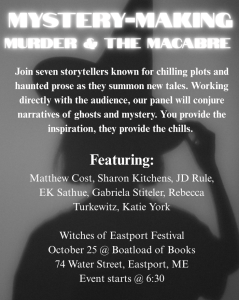
Cost will be participating in another mystery and ghost making event at the Witches of Eastport Festival with Gabi Stiteler and others in Eastport, Maine. Check it out HERE!
Should you happen to be in the Concord, Massachusetts area on October 27th, Dick Cass will be at the annual Concord Festival of Authors, joined by Kim Herdman Shapiro and Nicole Asselin, and hosted by Kate Flora. The event begins at 6 at the Concord Free Public Library. Always a great event.
An invitation to readers of this blog: Do you have news relating to Maine, Crime, or Writing? We’d love to hear from you. Just comment below to share.
And a reminder: If your library, school, or organization is looking for a speaker, we are often available to talk about the writing process, research, where we get our ideas, and other mysteries of the business, along with the very popular “Making a Mystery” with audience participation, and “Casting Call: How We Staff Our Mysteries.” We also do programs on Zoom. Contact Kate Flora
October 16, 2025
The Lowdown on a Class Action Lawsuit vs. AI
Kaitlyn Dunnett/Kathy Lynn Emerson here. On October 2, I received an email from the literary agency that handles my Kaitlyn Dunnett and Kate Emerson titles. The subject was the proposed $1.5 billion dollar settlement of a class action lawsuit case against Anthropic for using copyrighted novels to train AI without permission from the authors or publishers. I’d joined this class action months earlier, but without much hope of seeing any money out of the deal, especially after it was announced that only books that had their copyright filed with the copyright office would be included in the settlement. Anyone can add © to the copyright page of a book, and that has its uses, but in legal proceedings like this one, protection against “copyright infringement” only extends to those who have also completed all the paperwork. For novelists who are traditionally published, the publisher handles this . . . or not. Not is more common than one would think. I wrote sixty-four traditionally published books, some of which had reprint editions with other traditional publishers. As a result, I found eighty-two entries under three names on a list of books pirated for AI training. I had serious doubts that many of them were protected beyond the insertion of a © symbol.
Anyway, getting back to the letter. It was full of helpful suggestions for finding out if my books were included and how to proceed if they were, keeping in mind that this is a deal not yet approved by the court. That won’t happen until April, after all the claims are in, and there could still be an appeal. The deadline to file a claim is March 23, 2026, and each eligible “Work” on the “Works List” will be entitled to a share of settlement monies. If the “work” is still under contract, the publisher is co-rights holder and the payment for that book is split 50/50. If rights have reverted, the author gets 100% of the settlement amount. What that comes to in dollars will depend on how many people file claims and for how many titles, but the estimated payout looks to be the rough equivalent of what a mid-list author like me might expect to see from a sub-rights sale such as an audio-book, large print, or book club edition.
So, not expecting much, I followed the link to the Works List and typed in “Kate Emerson” to search. Four out of the six titles I published with Gallery Books were there. Why the other two aren’t, I have no idea. Then I checked “Kaitlyn Dunnett.” Although the publication dates overlap, none of the Deadly Edits mysteries are covered, but all thirteen of the Liss MacCrimmon Mysteries were copyrighted. Even with Kensington getting 50%, that will be a nice income boost.
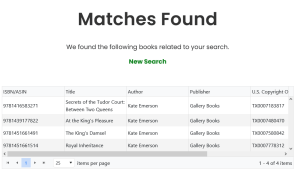
Then came the big question: did any of my many former publishers file copyrights on books that have reverted to me? I typed in “Kathy Lynn Emerson” and pretty much stopped breathing when the results came up. I believe my last words before my head exploded were “Holy crap!”
That list contained sixteen of my books.
Before I get into how complicated it is to put in a claim, there are a couple of anomalies worth mentioning. Of the five books I wrote for Harper Monogram, only one is on the list. Of the three I wrote for Harlequin/Silhouette, only one, of the six I wrote for Bantam Loveswept, only one. Many writer friends who published primarily with category romance publishers, have been cut out of the settlement entirely because no copyright paperwork was filed. On the other hand, St. Martin’s, who published the first seven Face Down Mysteries, copyrighted them all. Of my small press publishers, Pemberley Press copyrighted the four Diana Spaulding 1888 Mysteries and Crippen & Landru copyrighted the collection of short stories I wrote for them.
So now what? The website that lists eligible books also has a handy FAQ page and links to the form that needs to be submitted and to instructions for filling it (them) in. For those books with a 50/50 split it’s very easy to file claims, and more than one book can be listed on a single form (thank goodness!) but for the others? Keep in mind I am not complaining. In a couple of cases, the settlement amount is likely to be more than that book has earned to date. But there is a lot of jumping through hoops involved. For each of my sixteen Kathy Lynn Emerson titles I have to prove that the rights reverted to me by sending the relevant paperwork (contract or reversion letter or other proof) and in a couple of cases the publisher listed is not the one I had the original contract with and who (I assume) filed the copyright. I have no explanation for this, but it means supplying more paperwork to prove I have all the rights back. The form I have to fill out is daunting in itself, not least because it requires careful typing of a each ISBN and each U. S. Copyright Office number. Let’s just say it’s a good thing they’re allowing almost six months to file. Otherwise my head really might explode.
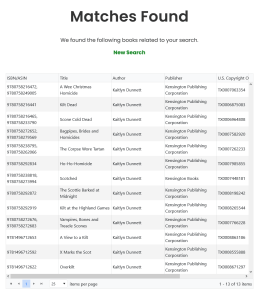
I had a couple of questions as I was going over what information to gather, so I sent an email to the info link listed at the settlement website as the place to send questions. I got a fast reply. Unfortunately it was an automated response with answers to FAQs and giving no indication that anyone would actually reply to my very specific questions. I’ll either have to figure the answers out on my own or use the phone number listed on the website to contact a lawyer being paid by the settlement to answer questions. After the email response, I foresee being put on hold for hours before being cut off without talking to a human being, but we shall see.
I’m hoping this information is useful, or at least interesting, to folks who read this blog. Fellow writers, check the list if there’s any chance your books might be on it. But even more importantly, check the copyright status of your titles. If your publisher didn’t register the copyright, you can do it. I don’t suppose another situation like this one will come along anytime soon—thousands of books illegally used to train artificial intelligence is pretty over the top—but you never know when having a legal leg to stand on could turn out to be important.

Kathy Lynn Emerson/Kaitlyn Dunnett has had sixty-four books traditionally published and has self published others. She won the Agatha Award and was an Anthony and Macavity finalist for best mystery nonfiction of 2008 for How to Write Killer Historical Mysteries and was an Agatha Award finalist in 2015 in the best mystery short story category. In 2023 she won the Lea Wait Award for “excellence and achievement” from the Maine Writers and Publishers Alliance. She was the Malice Domestic Guest of Honor in 2014. She is currently working on creating new editions of her backlist titles. Her website is www.KathyLynnEmerson.com.
October 15, 2025
My Path to Publication
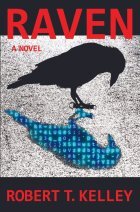 Rob Kelley here, and finally, at long last, after years, I’m about to be a published author. Raven releases from High Frequency Press on October 28, 2025 in paperback and ePub (and later in November as an audiobook on Audible).
Rob Kelley here, and finally, at long last, after years, I’m about to be a published author. Raven releases from High Frequency Press on October 28, 2025 in paperback and ePub (and later in November as an audiobook on Audible).
I wanted to share this story because I needed to hear ones like it during the long years it took to get here. Publication–getting your work out into the world–can seem like an infinitely receding horizon.
I know many people say they want to write books, and we’ve all heard and shared advice like “write every day,” “butt in chair,” and “you can’t edit what you haven’t written,” platitudes that rarely, at least for me, make writing easier. What has made writing easier, perhaps ironically, is more writing. My rough estimate is that the final thriller version of the book (it had its origins as SF!) underwent around 50 full revisions. Yikes!
I’d drafted early versions of the book almost 20 years ago, but only decided to take my writing seriously about 10 years ago. I started reading with purpose, making notes on other thrillers I read, and calling out techniques I wanted to emulate. I outlined books I admired to understand their structure. I started going to conferences–Maine Crime Wave, New England Crime Bake, Muse and the Marketplace, and ThrillerFest. I took classes online and in person, including from Stanford’s online catalog and Master Classes with D.P. Lyle, and our own Gayle Lynds and Chris Holm.
Then, when I thought I had the novel ready to go in 2019, I started looking for an agent. I pitched over 50. Some asked for pages, some for the full manuscript. No one took me on. So, I put the book down for a bit.
I worked on other projects (which have since become my next several books), continued attending writing conferences and taking classes, and eventually felt ready to pick the novel back up and get serious about improving it. It turns out there’s kill your darlings then there’s something more akin to mass murder. I was absolutely ruthless about improving the plot, the prose, the characters, and the voice.
In May 2023, I’d signed up for The Writer’s Hotel, the “mini MFA” conference that was now being held in Maine after moving from NYC. As part of acceptance to that conference I got a full MS read by the conference leads, authors Shanna McNair and Scott Wolven. As it turned out, I was only 42,000 words into my murderous revision at that moment, so I sent them that excerpt. And learned that I was not being murderous enough. Scott and Shanna did a level of editorial review that outstripped what I’d done for myself, down to word frequency and distribution. Double yikes!
I spent the summer editing hard and by fall of 2023 thought I was ready to resubmit to agents. I’d gone to ThrillerFest that summer and pitched in the speed dating PitchFest, I’d met a few agents through a program after The Writer’s Hotel. I also had my list of agents I’d pitched unsuccessfully, some sourced through prior ThrillerFest and Crime Bake “speed dating” pitches as well as research on Publishers Marketplace.
I sent it out to 12 agents who had expressed prior interest even if they hadn’t taken the earlier version and waited. But not for long. 10 days later I get an email from Shanna McNair that she and Scott Wolven had founded a press, High Frequency Press, and asked if I would be one of their inaugural writers. I politely withdrew my agent queries and received one reply from an agent who was clearly ready to take me on and asked to keep in touch. (I made a note of that!)
After many rounds of edits and various additional darlings killings, I come to this month, when Raven will launch. What I would have told my 10 and 20 years ago self is that it will be a slog. And that it will be worth it.
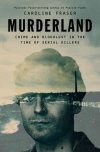
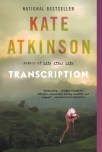 Currently reading: Murderland, Caroline Fraser, 2025,
Currently reading: Murderland, Caroline Fraser, 2025,
and Transcription, Kate Atkinson, 2018
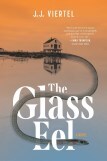 Next from my TBR list: The Glass Eel, J. J. Viertel, 2025
Next from my TBR list: The Glass Eel, J. J. Viertel, 2025
October 14, 2025
On Short Stories: A few helpful tips and tricks
A few weeks ago, my friend and fellow Maine writer Rebecca Turkewitz and I co-facilitated a roundtable discussion on short stories with other crime writers at the Maine Crime Wave. It was a fantastic chance to talk craft. (If you haven’t read Rebecca’s exceptional collection, Here in the Night, please check it out.)
I wanted to share some of the essential tips I’ve picked up along the way.
Why short stories?
Subtext. The short form allows writers to go deep, fast. For example, in my story “For Laura,” I focused on trimming out as much as possible, leaving the characters on the cusp of a tragedy they can do nothing to stop. But so much of suspense is what is left off the page, it’s the quiet between the sentences. The best writing allows for many interpretations, motives, and meanings.
The art of a the twist. Truly exceptional short story writers master the twist. I compare it to a magician’s sleight of hand: the twist should never be entirely unexpected. The great writers line the road with breadcrumbs; readers know something is coming. Twists with no crumbs feel undeserved, and too many crumbs make the plot predictable. In my flash piece, “Lubbock to El Paso” (available October 15th), I sprinkled small omens along the way to earn the ending in under 680 words.
Experimentation. Short stories offer a low-stakes environment for risk-taking that is difficult in a full-length novel. You can try a second-person POV, explore deeper, darker themes, and test ideas without committing to a massive time investment. This frees writers up to be truly innovative.
What resources are out there?
Short Mystery Fiction Society (SMFS): This free, fantastic listserv is where over a thousand of short story writers share calls for submission, market news, craft questions, and encouragement. SMFS also sponsors the Derringer Awards.Reach Out to Authors: Did you read a short story you loved? Email the author! When I started out, I tracked down three of my favorite writers and received outstanding advice and encouragement.Share what you love on social media and with friends: Take a minute to showcase what you’re enjoying. Write the reviews. Show up for book events. This writing stuff is hard. It means a lot when people shout out the good that they are reading.Where can I find a market?
When you join the SMFS, you get access to a comprehensive market list. Below are my personal favorites. (Full disclosure: my list skews toward dark, ambiguous, and literary crime fiction. Always check the submission requirements and read what the publication is putting out to get a sense of their distinct vibe.)
1.) Ellery Queen Mystery Magazine (EQMM): A gift to the genre. They published my first story and invest in new voices. Highly regarded and competitive, they pay professional rates. Response time is typically 3–4 months.
2.) Alfred Hitchcock Mystery Magazine (AHMM): A sibling publication to EQMM and a guaranteed good read. The editor reads every story, so the response time is longer—twelve months plus—but they pay professional rates.
3) Rock and a Hard Place (RHP): Great for noir and dark literary fiction (my go-to for edgy pieces). They take risks and produce interesting collections. Standard pay is $25 per story.
4.) Dark Yonder Focused on Neo-noir; they look for tightly written, deeply subversive, and unsettling stories. Pays $50 per story.
5.) Shotgun Honey Excellent small publisher for flash fiction (1,000 words or less) and unexpected themed anthologies. This is an online publication and offers $15 per story.
6.) Dark Waters Anthology (Annual): A podcasting duo that runs an annual call. Pay is $25. The call for submissions opens in the summer.
7.) Crime Spell Books (Annual): Publishes The Best New England Crime Writing anthologies. Pay is $25, and accepted authors are eligible for the Al Blanchard Award (which comes with a $250 cash prize). Calls for submission open in January
My latest stories:
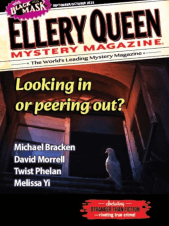 In Ellery Queen Mystery Magazine (September/October issue): My story, “A Hard Night’s Sleep,” explores a mother’s attempt to host a peaceful Thanksgiving, disrupted by her husband’s worsening condition and family resentment. The evening culminates in an act of violence that shatters the fragile world she was trying to protect.
In Ellery Queen Mystery Magazine (September/October issue): My story, “A Hard Night’s Sleep,” explores a mother’s attempt to host a peaceful Thanksgiving, disrupted by her husband’s worsening condition and family resentment. The evening culminates in an act of violence that shatters the fragile world she was trying to protect.
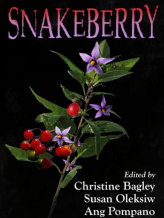 In Snakeberry: The Best New England Crime Writing: My story, “Money Well-Spent,” introduces Sloane, a cynical private investigator whose vacation is derailed by a blizzard and a troubled young woman. Sloane will reappear early next year in “The Best and Sweetest Things” in EQMM.
In Snakeberry: The Best New England Crime Writing: My story, “Money Well-Spent,” introduces Sloane, a cynical private investigator whose vacation is derailed by a blizzard and a troubled young woman. Sloane will reappear early next year in “The Best and Sweetest Things” in EQMM.
New story up on Shotgun Honey on 10/15. Check it out online on Wednesday (10/15) HERE.
Upcoming Events:
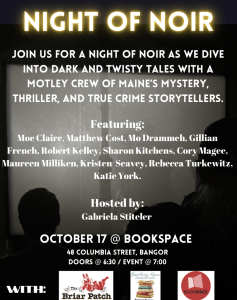
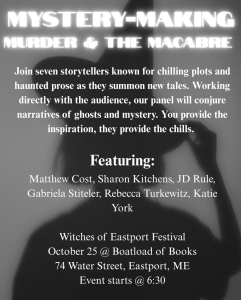
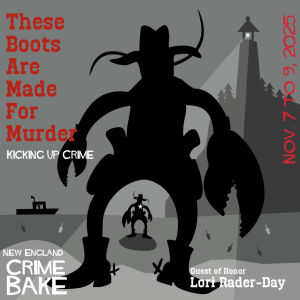
Stay well, and we’ll connect again in November.
Gabi
October 12, 2025
SEO #3: Google Ranking Factors
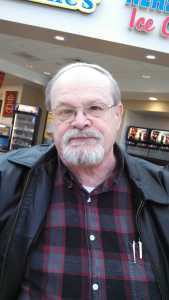
Vaughn C. Hardacker
This is the third post on Search Engine Optimization (SEO), and I will conclude with how Google ranks webpages. As I’ve stated before, Google controls 90% of the search market. Therefore, if we are going to use SEO, it only makes sense that we see how Google Ranks Pages. I a previous blog I mentioned that there are two ranking factores, On Page and Off Page. This is not entirely true; there are three:
Off-page. These are being measured by Google elsewhere from your site and primarily involve backlinks.On-Page. These are mainly related to the keywords and informational quality of your pages.Technical. These are also measured on-site, but have more to do with the overall performance of the site as a whole, as opposed to individual pages.We now have the foundation. Let’s look a bit deeper.
Top 10 Google Ranking FactorsFor search engines to crawl and index your web page correctly, certain core technical elements or factors must work seamlessly. These are the back-end building blocks that make up your site so it will function the way it should.
Technical Ranking Factors: Deal with the website as a whole.Site and page speed. No one likes to wait for a slow page to load. whether on your phone or computer. How patient are you? If it aggravates you, it will make many searchers go elsewhere. Google agrees with the searcher on this. If your page is slow, your bounce rate will increase, a big no-no for Google. Your ranking will sink like the Titanic. There are tools to help improve page speed. Among these are GTmetrix and Google PageSpeed Insights (both are free), which provide valuable insights into site speed, allowing for easy optimization.Usability on mobile. Even if your website is top-of-the-line on computers, but you have a subpar mobile version, your ranking will take a significant hit. Therefore, it is essential to preview both platforms before going live. This is important because Google uses mobile-first indexing when crawling websites. Ensure your hosting platform (i.e., WordPress or Wix) has built-in features that allow you to preview your website before publishing. You can also use a free mobile usability testing tool, such as Google Mobile-Friendly Test, to ensure everything is okay. Internal links. In my previous blog, I spoke about including links on your site. Why should you? For search engines to do a good job of crawling and indexing your pages, they need to follow links wherever they may lead. The links on your page help them analyze and properly index your pages. Internal links are the hyperlinks you place on your pages to link to other pages on your site. Proper linking is a huge benefit to your site. To do this, you should use topic clusters. This is when you create content around a specific umbrella pillow (think genealogy chart) and link each to the others in the cluster. For instance, think of a genealogical chart. The topic cluster would be family surname, and the pillow would represent the 1st generation, followed by 2nd to 3rd, and so on. This keeps your links tightly organized … Google and other search engines love this.On-Page Ranking Factors: Are page-specific Keyword Targeting. Keywords are the backbone of an efficient SEO strategy. All content and articles should revolve around these search phrases. These keywords become the clusters mentioned above. You need to find at least four to five related keywords and group them into clusters. Caution: Add these keywords or phrases. Do not stuff them just because you want to rank. Google is smarter now, and your site will drop in ranking.Title and Header Tags. Once you have identified the keywords you want to rank for, it is essential to insert them in specific places on your page, such as the title and header tags. Search engines use these tags to determine the content of the page and index it accordingly. The title tag is what is displayed prominently in the search results pages.Meta Description. A short description that appears on SERPs under your page title. They are part of the HTML of your pages. They do not appear on the front of your pages and are not visible to site visitors.Image alt-text. Images on your site have SEO value attached to them via alt-text. This description serves to illustrate the image and fulfills several purposes. (a) It makes your website accessible to visually impaired readers who rely on screen readers to browse the internet. (b) If your image fails to load, the alt-text will appear in its place. (c) It helps search engines to understand the image and index it properly.URL structure. An ugly URL is not appealing to people or search engines. Ensure your URL is well-structured to appear visually appealing. Poorly structured URL: http://www.website.com/us.php?id=03736&edit=1 Properly structured URL: http://www.website.com/blog/google-ranking-factorsInformation quality. Quality should be above par. You need to update outdated content on your site. Quality content provides enough detail to answer all your visitors’ questions in a way that leaves them satisfied. Don’t forget that Google values both freshness and accuracy when determining rankings.
Off-Page Ranking Factors: Rankings outside your website, such as social media platforms, influencers, and other websites.Backlinks. These are hyperlinks that contain pages from outside. Part of SEO is building trust, and when other websites link to you, it shows Google that you are a trusted source. This improves your credibility and ranking. Therefore, the pages linking to you must also be high quality.Question of the day. “How do you get backlinks?”
Answer: Four ways.
Quality Content. To earn backlinks, your content must be high quality. If your site generates numerous backlinks, this will help increase your authority, which is a signal to Google that you are a reputable source, resulting in a better ranking.Cold Outreach. You reach out to other webmasters and ask them to link to your content. You must provide value and demonstrate the value you offer. What they link to must complement what they already have or be better than,Guest Posts. Write content for other websites, and they agree to leave a link back to your site or content on the bio section of the page. As always, we only offer high-quality products.Thought Leadership Content. A growing number of marketers are recognizing the value of thought leadership backlink building. There are two parts to this strategy. (a) Identify opportunities to get featured on podcasts, webinars, or other forms of media. (b) Create data-driven content that generates links naturally.NOTE: It’s essential to recognize that there is no single factor that will make or break your SEO. It’s the combination of all your technical, on-page, and off-page efforts that work together to build an SEO-friendly website.
In closing. If nothing else, I hope this series of blogs has illustrated what an effective website is from an SEO perspective (as well as explaining why it costs what it does to have a Great webpage designer build your page). To quote an old IT saying: GI-GO. “Garbage In-Garbage Out. Doing it right will pay off.
As we approach the busiest time of my year, I will not be posting again until after January 1. I am highly active in veterans’ issues (Commandant of the northern most Marine Corps League detachment in the country, life member of three vetran groups–VFW, DAV, & MCL, Maine Veteran Cemetery Committee, and founder and chair of the Aroostook Veterans Advocacy Committee) and we have Veterans’ Day as well as some group specific events coming up in November and December
I am currently working on the rewrite of the third installment of my Houston & Bouchard series (my editor is awaiting the final draft), in addition to a number of upcoming events and appearances, as well as the holiday season. I have to back away for a while.
If anyone is interested in adding backlinks between your website and mine, contact me via my page: https://vaughnhardacker.com. I’ve already spoken with my web designer, Melissa Gerety (who I highly recommend), and she has informed me that it is not a significant thing to add a links page. All I need to do is send the links. So, send in those links, People!
October 10, 2025
Weekend Update: October 11-12, 2025
 Next week at Maine Crime Writers there will be posts by Vaughn Hardacker (Monday), Gabi Stiteler (Tuesday), Rob Kelley (Thursday), and Kaitlyn Dunnett/Kathy Lynn Emerson (Friday).
Next week at Maine Crime Writers there will be posts by Vaughn Hardacker (Monday), Gabi Stiteler (Tuesday), Rob Kelley (Thursday), and Kaitlyn Dunnett/Kathy Lynn Emerson (Friday).
In the news department, here’s what’s happening with some of us who blog regularly at Maine Crime Writers:
Kate Flora is hitting another bookstore:
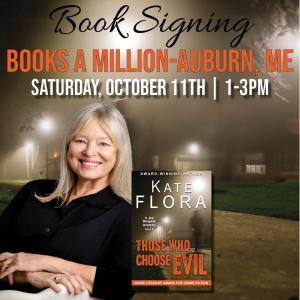
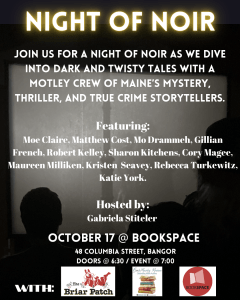
Matt Cost will be joining a motley crew of Maine’s mystery, thriller, and true crime storytellers on October 17th at 7 PM in Bangor. Come check out a Night of Noir at BookSpace at 48 Columbia in Bangor.
An invitation to readers of this blog: Do you have news relating to Maine, Crime, or Writing? We’d love to hear from you. Just comment below to share.
And a reminder: If your library, school, or organization is looking for a speaker, we are often available to talk about the writing process, research, where we get our ideas, and other mysteries of the business, along with the very popular “Making a Mystery” with audience participation, and “Casting Call: How We Staff Our Mysteries.” We also do programs on Zoom. Contact Kate Flora
My Word Count Obsession

I am a prolific word counter. Yes, I’m a bit obsessed with how many words I’m writing at any given point during my novel-writing process. How did this weird compulsion to be?
Writing a novel is akin to running a marathon. A runner constantly check their time, pace and miles. Or maybe a better analogy would be like building wealth. Sure, you could spend all your money trying to hit the lottery. Or betting your life savings on the roulette wheel. But wouldn’t it be better to save some money every week and invest it? Build wealth instead of trying to make a big score? Of course the big score is sexier and more cinematic. But remember the story of the tortoise and the hare? Slow and steady sometimes wins the race, especially when it comes to writing. And how many of us can write a novel in a day? Or a week? Unless you’re Jack Kerouac writing On The Road on a 120-foot-long scroll of tracing paper.
I often wonder how people back in the day wrote without that little word count box on the right corner of the screen, keeping them in check. I did at one time, oblivious to the ways in which those numbers mattered. Now those numbers ground me, and speak to me about my daily progress. Often, I have to grind out a certain number each day, and I don’t stop until I’ve reached it.
People marvel when I tell them I’ve finished a novel. They often say that they could never achieve such a feat. Admittedly, it is difficult. But then I think about what they’ve said from their perspective. They look at a novel in its entirety, seeing it as singular, monolithic achievement. And it is, to a degree. But writers view that novel differently. Or at least I do. I see the novel as a series of word-building blocks stacked high. Like Legos. Blocks of words arduously formed into sentences. Blocks of sentences arduously formed into paragraphs. Blocks of paragraphs arduously formed into chapters. You get the point.
People say it’s too hard to write a novel. I tell them that if they wrote five hundred words every day for five months they would have a working first draft. An hour each day. An hour of discipline and a dash of inspiration. Sometimes it’s hard to teach the grind, but the grind is all I know as a writer. Not sure creative writing departments teach the grind, and that’s the hardest trait to develop. Grind. Never give up. Keep sitting in that chair and pushing out the words. And that’s where word counting helps me out.
I used to make myself write thirteen hundred words a day come rain or shine. If I wrote beyond that I could bank the extras for a rainy day. Or take a day off. If I didn’t meet my goal, I would have to write more words the next day to make up for the deficit. Couldn’t steal words from someone else.
In this day and age of literary austerity, managing word count matters for a novelist. The days of writing nine hundred page novels are a thing of the past, especially for crime writers. A workable word count for a mystery/crime novel is anywhere between 80,000 to 100,00 thousand words. Publishers have to manage paper costs, as well as cater to the demands of readers who have shorter attention spans. Thus, the need to keep an eye on that little box on the top left corner of the screen is imperative.
I could go on and on about this seemingly mundane subject. It’s not just good enough to be a writer these days. One needs to be an accountant of words. A CPA of literature. A story auditor. Bookkeeper of ideas. Words matter in this business, but so do numbers. Keeping track of them could be the difference between getting published and a rejection letter. So watch your words, brother. Numbers don’t lie, sister. Do the right thing and watch your word count.
I am a prolific word counter. Yes, I’m a bit obsessed with how many words I’m writing at any given point during my novel-writing process. How did this weird compulsion to be?
Writing a novel is akin to running a marathon. A runner constantly check their time, pace and miles. Or maybe a better analogy would be like building wealth. Sure, you could spend all your money trying to hit the lottery. Or betting your life savings on the roulette wheel. But wouldn’t it be better to save some money every week and invest it? Build wealth instead of trying to make a big score? Of course the big score is sexier and more cinematic. But remember the story of the tortoise and the hare? Slow and steady sometimes wins the race, especially when it comes to writing. And how many of us can write a novel in a day? Or a week? Unless you’re Jack Kerouac writing On The Road on a 120-foot-long scroll of tracing paper.

Lea Wait's Blog
- Lea Wait's profile
- 507 followers



